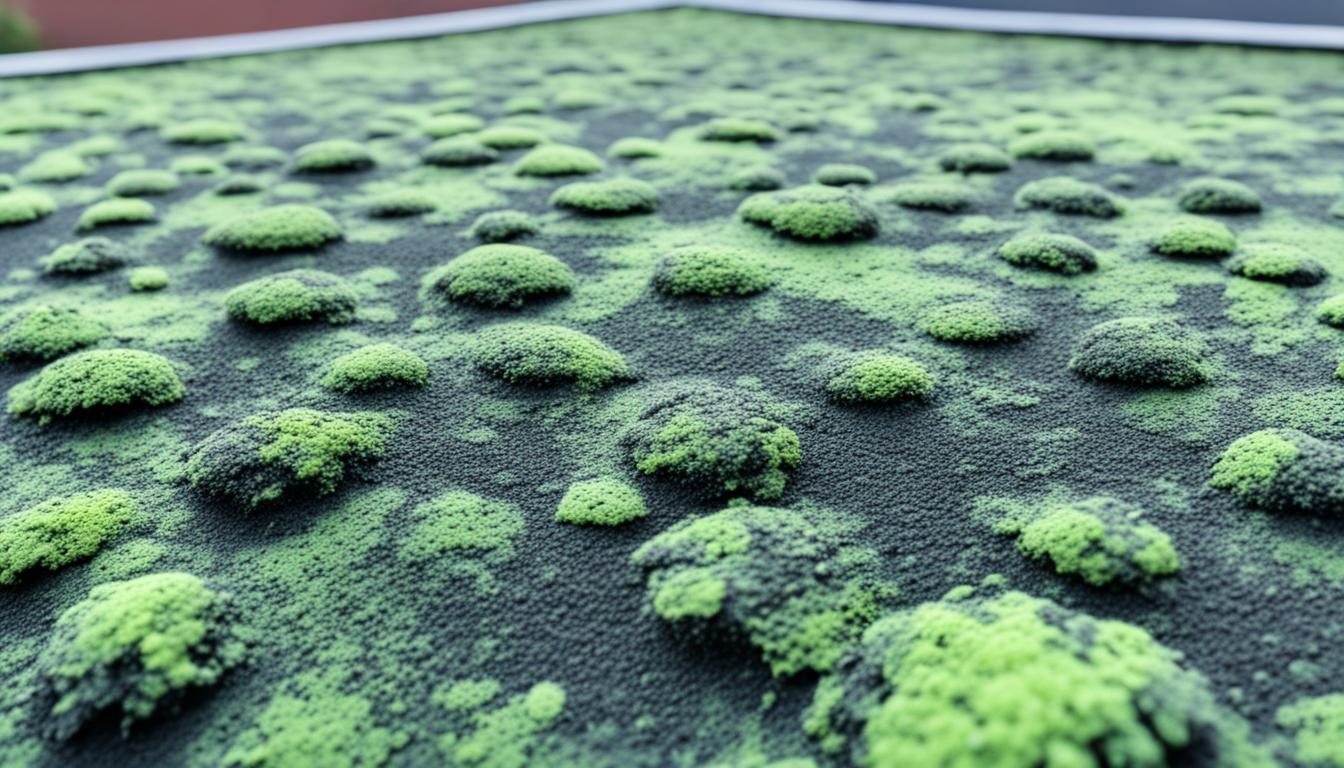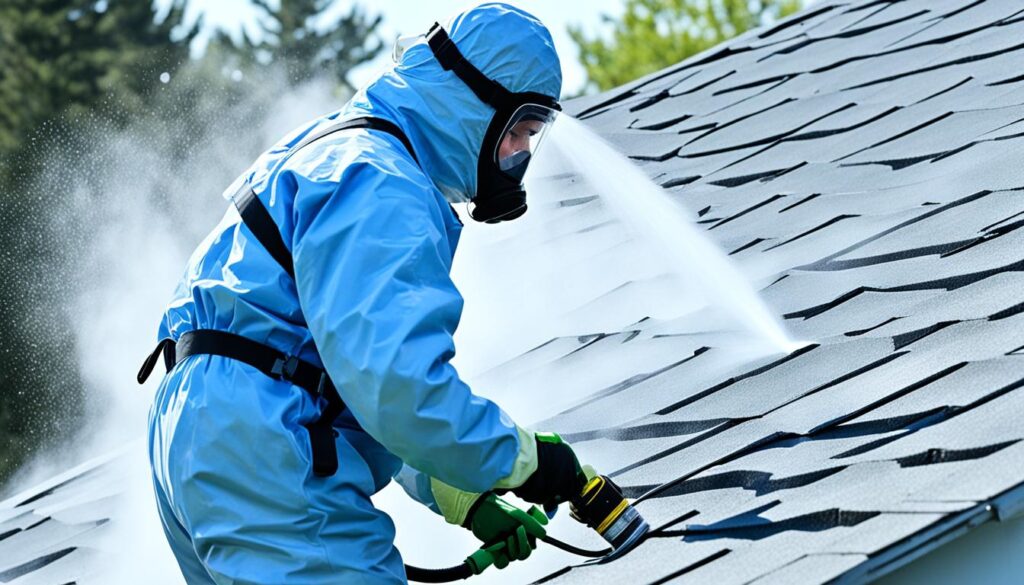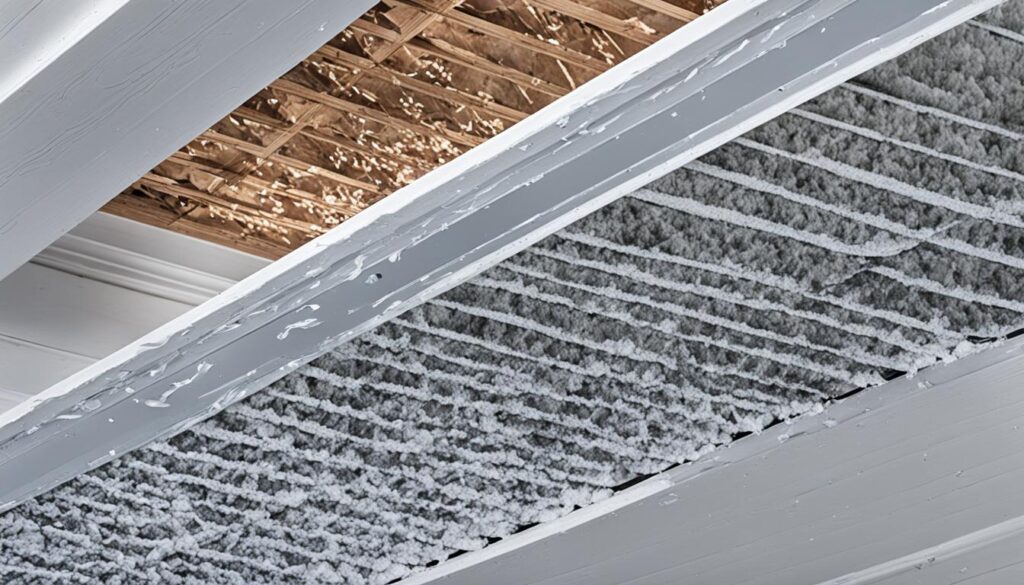
Eradicate Mold on Roof: Effective Removal Tips
Mold on the roof can be a serious issue that requires immediate attention. If left untreated, it can compromise the integrity of your home and pose health risks to you and your family. In this article, we will provide expert tips and strategies for effectively removing mold from your roof. By following these tips, you can eliminate mold and safeguard your home.
Key Takeaways:
- Address mold on your roof promptly to prevent further damage and health risks.
- Understanding the dangers of mold is crucial before starting the removal process.
- Recognize the signs and symptoms of mold, such as visible black or green spots, a musty odor, and water stains on the ceiling.
- Take necessary precautions and follow safety measures during mold removal to protect yourself and prevent the spread of spores.
- If the mold is limited, you can attempt DIY removal techniques, but seek professional help for severe cases.
Understanding the Dangers of Mold on Roof
Mold on your roof can pose significant risks to your health and the integrity of your home. It’s important to be aware of these dangers in order to take appropriate action. Let’s explore the potential hazards of mold on your roof.
1. Release of Harmful Spores
When mold grows on your roof, it releases tiny spores into the air. These spores can easily be inhaled and lead to various respiratory issues. Individuals with allergies, asthma, or weakened immune systems are particularly susceptible to the negative effects of mold spores.
2. Health Impacts
Inhaling mold spores can cause a range of health problems, including coughing, sneezing, wheezing, nasal congestion, throat irritation, and respiratory infections. Prolonged exposure to mold can also lead to more severe health conditions, such as bronchitis and even lung damage.
3. Structural Damage
Mold growth on your roof can compromise its structure. Over time, mold can weaken the roofing materials, causing them to deteriorate and potentially leading to leaks. If left untreated, mold can spread to other areas of your home, causing damage to walls, ceilings, and insulation.
4. Reduced Indoor Air Quality
Mold releases volatile organic compounds (VOCs) that can contribute to poor indoor air quality. These VOCs can result in unpleasant odors and cause irritation to your respiratory system. It’s important to address mold on your roof promptly to maintain a healthy indoor environment.
“Addressing mold promptly is crucial to mitigate the risks it poses to your health and the structural integrity of your home.”
By understanding the dangers associated with mold on your roof, you can make informed decisions and take the necessary steps to ensure its removal. Prompt action is key to safeguarding your health and preventing further damage to your home.
Signs and Symptoms of Mold on Roof
Identifying the presence of mold on your roof is the first step towards its removal. By recognizing these indicators, you can take appropriate action to eliminate mold and protect your home. Some common signs and symptoms of mold on the roof include:
- Visible black or green spots on the roof surface
- A musty odor in the attic or living spaces
- Water stains on the ceiling or walls
If you notice any of these signs, it’s important to address the issue promptly to prevent further damage and health risks. Mold can spread quickly and compromise the structural integrity of your roof.
Take a look at the image below to get a visual representation of mold on a roof:
“Mold can cause serious health problems if left untreated. It’s essential to recognize the signs and symptoms to protect your home and loved ones.”
Precautions and Safety Measures
Mold removal requires careful precautions to ensure your safety and prevent the spread of spores. By following these safety measures, you can effectively mitigate health risks during the removal process:
1. Wear Protective Gear
When handling mold, it’s essential to wear the appropriate protective gear to minimize exposure. This includes:
- Disposable Gloves: Protect your hands from direct contact with mold and cleaning solutions.
- Face Mask: Use a respirator mask with an N-95 or higher rating to prevent inhalation of mold spores.
- Eye Protection: Wear safety goggles or glasses to shield your eyes from airborne spores.
- Disposable Coveralls: Use coveralls or old clothing that can be discarded after the removal process.
2. Isolate the Affected Area
To prevent the spread of mold spores to other parts of your home, it’s crucial to isolate the affected area. Follow these steps:
- Close Doors and Windows: Seal off the room by closing all doors and windows.
- Use Plastic Sheets: Cover doorways and vents with plastic sheets to prevent cross-contamination.
- Tape Seams: Secure the plastic sheets with duct tape to ensure a tight seal.
3. Ensure Proper Ventilation
Proper ventilation is key during mold removal to minimize the concentration of airborne spores. Follow these ventilation guidelines:
- Open Windows: If possible, open windows in the affected area to improve air circulation.
- Use Fans: Place fans strategically to direct air flow towards the windows and outside.
- Avoid Air Recirculation: Turn off central air conditioning or heating systems to prevent spore distribution.
4. Use Mold-Specific Cleaning Solutions
When cleaning moldy surfaces, it’s important to use appropriate cleaning solutions that are specifically designed to kill mold. Look for products that contain ingredients like bleach, hydrogen peroxide, or commercial mold killers. Follow the manufacturer’s instructions for dilution and application.
5. Handle and Dispose of Materials Safely
After removing moldy materials, take extra precautions when handling and disposing of them to avoid recontamination:
- Double-Bagging: Place moldy materials in plastic bags and double-bag them to prevent spores from escaping.
- Seal Bags Properly: Securely seal the bags with duct tape to ensure airtight closure.
- Dispose of Bags: Dispose of the bags in accordance with local regulations for mold-contaminated materials.
By following these precautions and safety measures, you can effectively remove mold from your roof while safeguarding your health and preventing the spread of spores.
| Safety Measure | Description |
|---|---|
| Wear Protective Gear | Disposable gloves, face mask, eye protection, and coveralls |
| Isolate the Affected Area | Close doors and windows, use plastic sheets, tape seams |
| Ensure Proper Ventilation | Open windows, use fans, avoid air recirculation |
| Use Mold-Specific Cleaning Solutions | Choose products with bleach, hydrogen peroxide, or commercial mold killers |
| Handle and Dispose of Materials Safely | Double-bag, seal bags properly, dispose of according to regulations |
DIY Mold Removal Techniques
If the mold on your roof is limited and not extensive, you may be able to tackle the removal process yourself. This section will provide step-by-step instructions and techniques for safely removing mold, including using a mold-killing solution, scrubbing affected areas, and ensuring thorough drying. However, it’s important to know when to call professionals for more severe cases.
-
Gather the necessary supplies
Before you begin the mold removal process, make sure you have the proper supplies. This includes:
- Protective gear such as gloves, goggles, and a mask
- A mold-killing solution or a mixture of water and bleach
- A stiff-bristle brush or sponge
- Plastic sheets or tarps to cover nearby areas
- A vacuum cleaner with a HEPA filter
-
Prepare the affected area
Prior to starting the mold removal process, take precautions to protect yourself and the surrounding area:
- Seal off the affected area with plastic sheeting or tarps to prevent the spread of mold spores
- Open windows and doors to ensure proper ventilation
- Turn off HVAC systems to prevent mold spores from spreading
-
Apply the mold-killing solution
Using a spray bottle or a sponge, apply the mold-killing solution to the affected areas. Allow the solution to sit for a few minutes to ensure it penetrates the mold.
-
Scrub the affected areas
Using a stiff-bristle brush or sponge, scrub the mold-infested areas vigorously. Be sure to remove all visible mold and pay extra attention to any porous surfaces that may have absorbed mold.
-
Thoroughly dry the area
After scrubbing, use a clean, dry cloth to wipe away any excess moisture. Properly drying the area is essential to prevent mold from returning.
-
Dispose of any contaminated materials
If you encounter mold-infested materials that cannot be salvaged, such as drywall or carpeting, carefully bag and dispose of them following local regulations.
-
Monitor for mold recurrence
Keep an eye on the treated area to ensure that mold does not come back. If you notice any signs of mold growth or persistent moisture issues, consider contacting professionals for further inspection and remediation.
Remember, while DIY mold removal may be suitable for smaller mold problems, it’s crucial to assess the extent of the infestation and prioritize your safety. If you’re unsure or dealing with a severe mold issue, it’s always best to seek professional help.

Professional Mold Removal Services
When it comes to larger or more severe cases of mold on your roof, it is highly recommended to enlist the expertise of professional mold removal services. These professionals are equipped with the knowledge and tools to effectively eliminate mold while minimizing its recurrence.
One of the key benefits of hiring experts in professional mold removal is their ability to identify the root cause of the mold. By understanding the underlying factors contributing to mold growth on your roof, they can develop a targeted plan to address the issue and prevent future mold infestations.
Additionally, professional mold removal services utilize specialized equipment and techniques that ensure thorough and efficient mold removal. They have access to advanced technologies that can detect hidden mold, including infrared cameras and moisture meters. By employing these tools, professionals can identify mold growth in hard-to-reach areas and ensure comprehensive removal.
The Advantages of Professional Mold Removal Services:
- Expert Knowledge: Professional mold removal technicians are trained and experienced in dealing with mold infestations of all sizes and complexities. They have in-depth knowledge of different types of molds and their specific removal requirements.
- Safe and Effective Practices: Mold removal experts follow industry guidelines and standards to ensure the safety of both occupants and technicians. They employ proper containment techniques to prevent cross-contamination and take necessary precautions to protect against health hazards.
- Preventing Recurrence: Professionals not only remove mold but also address the underlying causes of mold growth. By identifying and remedying issues such as moisture intrusion or inadequate ventilation, they minimize the chances of mold reappearing in the future.
- Time and Cost Savings: Hiring professionals can save you valuable time and money. They have the necessary equipment, manpower, and expertise to efficiently complete the mold removal process, ensuring a thorough and long-lasting solution.
In summary, professional mold removal services offer numerous advantages when dealing with larger or severe mold infestations on your roof. Their knowledge, specialized equipment, and effective techniques enable them to eliminate mold while minimizing its recurrence. By entrusting the task to experts, you can ensure the safety of your home and enjoy a mold-free environment.
Preventing Future Mold Growth
Once you have successfully eradicated mold from your roof, it’s essential to take measures to prevent its reoccurrence. By implementing these mold prevention tips, you can maintain a healthy and mold-free environment in your home.
Regular Roof Inspections
Regular roof inspections are crucial for detecting any signs of mold growth early on. Schedule professional inspections at least once a year to identify and address any potential issues before they escalate. Additionally, keep an eye out for any visible signs of water damage or moisture buildup.
Promptly Address Water Leaks
Water leaks can contribute to mold growth on your roof. Whenever you notice a leak, it’s important to address it promptly to prevent water from seeping into your home’s structure. Repairing leaks promptly will help minimize the opportunity for mold to grow and spread.
Promote Proper Ventilation
Poor ventilation can create an environment conducive to mold growth. Ensure proper airflow in your home by opening windows, using exhaust fans in kitchens and bathrooms, and installing attic vents. Ventilation helps control moisture levels and discourages mold from thriving.
Control Indoor Humidity Levels
Mold thrives in damp environments, making it crucial to control indoor humidity levels. Use a dehumidifier in areas prone to excessive moisture, such as basements or laundry rooms. Aim to maintain indoor humidity levels between 30% and 50% to deter mold growth.
Quick Mold Prevention Tips
| Prevention Tips | Description |
|---|---|
| Keep gutters clean | Regularly clean and maintain gutters to prevent water from overflowing and seeping into the roof. |
| Remove outdoor debris | Clear any leaves, branches, or other debris from the roof to prevent moisture buildup. |
| Trim overhanging branches | Trim any tree branches that hang over your roof to reduce shade and promote proper sunlight exposure. |
| Inspect for roof damage | Regularly inspect your roof for any signs of damage, such as cracked shingles or loose tiles, and address them promptly. |
By following these mold prevention tips and implementing regular maintenance measures, you can significantly reduce the risk of mold growth on your roof. Creating a proactive approach to mold prevention will help keep your home safe, healthy, and free from mold-related issues.

Maintaining a Healthy Roof Environment
A healthy roof environment is crucial for preventing mold growth and preserving the integrity of your home. By following these roof maintenance tips, you can ensure that your roof remains in optimal condition, reducing the risk of mold and other issues.
Keep Gutters Clean
Maintaining clean gutters is essential for a healthy roof environment. Clogged gutters can cause water to overflow onto the roof, leading to moisture buildup and mold growth. Regularly remove leaves, debris, and any obstructions from your gutters to ensure proper drainage.
Remove Debris
Regularly remove debris such as leaves, branches, and twigs from your roof. This prevents them from trapping moisture, which can create an ideal environment for mold to thrive. Use a leaf blower or a soft-bristle broom to gently sweep away the debris without damaging the roof’s surface.
Trim Overhanging Branches
Overhanging branches not only pose a risk of falling onto your roof but can also provide direct access for moisture, leaves, and debris. Trim back any branches that are touching or hanging too close to your roof to prevent damage and keep your roof free from unnecessary moisture sources.
Inspect for Damage or Deterioration
Regularly inspect your roof for any signs of damage or deterioration. Look for missing or damaged shingles, cracked flashing, or any other signs of wear and tear. Timely repairs can help maintain the structural integrity of your roof and prevent water intrusion that can lead to mold growth.
| Roof Maintenance Tips | Description |
|---|---|
| Keep Gutters Clean | Maintain clean gutters by removing leaves and debris regularly to ensure proper drainage. |
| Remove Debris | Regularly remove debris from your roof to prevent moisture buildup and mold growth. |
| Trim Overhanging Branches | Trim back overhanging branches to prevent damage and minimize moisture sources. |
| Inspect for Damage or Deterioration | Regularly inspect your roof for signs of damage or deterioration and address them promptly. |
By following these roof maintenance tips, you can create a healthy roof environment that not only prevents mold growth but also extends the lifespan of your roof. Remember, a well-maintained roof is a key investment in the overall well-being of your home.
Conclusion
In conclusion, it is crucial to take immediate action to eliminate mold on your roof. Mold growth poses serious risks to your home’s structural integrity and your health. By promptly addressing mold issues and implementing effective removal techniques, you can ensure a healthy and mold-free roof environment.
Remember to follow proper precautions during the removal process to minimize health risks and prevent the spread of mold spores. If you are unsure about tackling the problem on your own or if the mold is extensive, it is advisable to seek professional mold removal services. They have the expertise, specialized equipment, and knowledge to identify the root cause of mold and effectively eliminate it.
To prevent future mold growth, it is important to conduct regular roof inspections, address water leaks promptly, promote proper ventilation, and maintain a healthy roof environment. Taking preventive measures will help safeguard your home and prevent mold from resurfacing.
If you require professional assistance with mold assessment or removal, do not hesitate to contact Fix Mold Miami at 305-465-6653. Their experienced team can provide expert guidance and ensure a thorough inspection of your roof for any mold-related issues.




